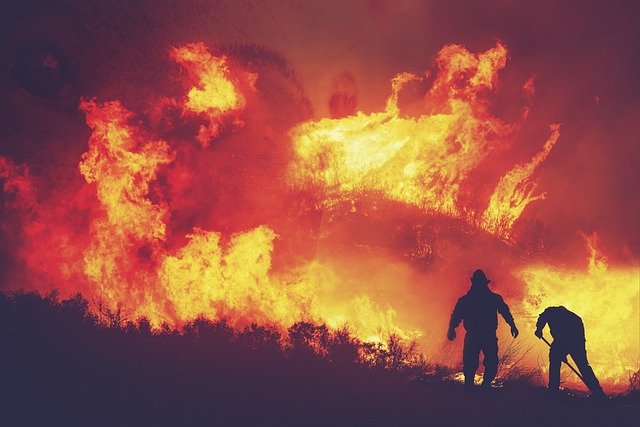In the past, every American could quote Smokey Bear, “Only you can prevent forest fires.” This message from U.S. Forest Service’s 76-year-old mascot is often lost in the digital noise today, but it is more relevant now than ever.
In the first nine months of 2020 in the United States, 44,714 wildfires burned about 7.8 million acres, killed dozens of people, and blanketed the entire West Coast in a choking layer of smoke pollution. Fortunately, you can prevent forest fires.
Wildfires
The American west and many other environments are adapted to seasonal wildfires. But decades of fire suppression reversed centuries of natural fire indigenous land management that lowered the risk of uncontrolled wildfire. Combined with climate change and careless human activities has produced recurring megafires.

Although lightning played an unusually large role in this year’s California fire season, about 90% of wildfires are actually caused by human negligence. An untended campfire can spread. A cigarette tossed from a car window or spark from an exhaust pipe can set off grass fires that spread to nearby forests. Unlike controlled burns that clear underbrush and encourage new growth, human-sparked wildfires are tremendously damaging to the environment and dangerous to people.
Megafires are too big for wildlife to outrun, leading to huge losses of life, and eliminate habitat across huge areas. High-severity fires also disrupt tree regeneration, increase soil erosion, lower water quality, and facilitate the growth of invasive species. The harm is not even limited to the fires’ path — smokestorms can harm human health hundreds of miles away, and contribute to climate change.
Safer Open Fires
Make sure a fire is appropriate in the first place. The safest and least polluting campfire is no campfire at all. Permits are required for campfires and portable gas stoves on federal lands; check to see if your state parks have similar requirements. Always check for local fire restrictions. Campfires are banned when the fire risk is high.
Learn how to build a campfire safely, and never leave a fire unattended. Before you leave the campsite, extinguish the fire completely using the “drown, stir and feel” method. If the ashes are still hot after the first dousing, pour more water on until they are cold. When camping, even if you aren’t burning a fire, keep a shovel and a bucket of water nearby at all times.
In some areas and at certain times, it is legal to burn debris. Usually, a permit is required. Always check local regulations before burning debris. If you must burn debris, learn how to do it safely, but consider whether composting or even disposal might be a better choice.
One Less Spark – One Less Wildfire
Any activity that generates sparks in a dry environment is a fire hazard. This is why fireworks, exploding targets, and any other incendiary devices are banned on federal public lands (and are a bad idea in any natural area).
The El Dorado Fire in Southern California that burned 22,700 acres was ignited by pyrotechnics at a gender reveal party. It wasn’t even the first wildfire started by a gender-reveal party, but don’t be too quick to focus on social-media theatrics. The Mendocino Complex Fire of 2018 was ignited when a man hammered a metal stake into the ground — a spark flew into the brush and ignited.
You Can Prevent Vehicle-Caused Fires
Moving vehicles shouldn’t throw out sparks, but they often do, and those sparks can lead to wildfires.
The Carr Fire in 2018 started by the metal rim of a flat tire on a trailer setting off sparks when it struck the asphalt. Maintain your brakes and tire pressure (this will improve your gas mileage, too). Make sure that nothing attached to your car — like tow chains, a sagging muffler, or items in the truckbed — drag on the ground.
Drive only on pavement — hot exhaust pipes can spark fires in dry grass. And carry a fire extinguisher in your vehicle so that stray sparks don’t turn into big fires.
You Can Prevent Equipment-Caused Fires
Landscaping for fire resistance requires proper maintenance, but garden equipment can start fires. In fact, lawn mowers, weed-eaters, chain saws, grinders, welders, tractors, trimmers, and even guns can all spark a wildfire.
Don’t use such equipment during the hottest part of the day or during windy conditions. Electric yard equipment may be safer. If you use gas-powered equipment, make sure it’s equipped with spark arresters and the correct fuel. When using non-landscape equipment, always work in an area cleared of vegetation.
When you are finished using yard equipment, check your property to ensure sparks from the engine or a blade striking a rock has not ignited the brush. A fire can start slowly in grass, then accelerate quickly once it has ignited dryer materials.
Be Prepared
Shovels, water, and fire extinguishers are all good tools to keep on hand wherever there is a risk of fire. Quickly smothering a spark that catches can prevent a fire from growing.
If you are in an area with cell reception, do not hesitate to call 911 if you start or spot a fire. Wildfires can spread alarmingly fast, and even if you sound a false alarm, it’s better than being the cause of the next El Dorado Fire.
Feature image by Marcus Kauffman on Unsplash
The post Wildfire Prevention: Where Safety and Environmentalism Connect appeared first on Earth 911.








